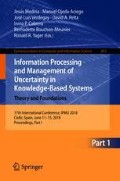Abstract
Probabilistic classifiers output a probability of an input being a member of each of the possible classes, given some of its feature values, selecting most probable class as predicted class. We introduce and compare different measures of the feature strength in probabilistic confidence-weigthed classification models. For that, we follow two approaches: one based on conditional probability tables of the classification variable with respect to each feature, using different statistical distances and a correction parameter, and the second one based on accuracy in predicting classification from evidences on each isolated feature. On a case study, we compute these feature strength measures and rank features attending to them, comparing results.
Access this chapter
Tax calculation will be finalised at checkout
Purchases are for personal use only
References
Delgado, R., González, J.L., Sotoca, A., Tibau, X.-A.: A Bayesian network profiler for wildfire arsonists. In: Pardalos, P.M., Conca, P., Giuffrida, G., Nicosia, G. (eds.) MOD 2016. LNCS, vol. 10122, pp. 379–390. Springer, Cham (2016). https://doi.org/10.1007/978-3-319-51469-7_31
Friedman, J., Hastie, T., Tibshirani, R.: The Elements of Statistical Learning. Springer Series in Statistics, vol. 1, pp. 337–387. Springer, New York (2001). https://doi.org/10.1007/978-0-387-21606-5
Huang, J., Ling, C.: Using AUC and accuracy in evaluating learning algoritms. IEEE Trans. Knowl. Data Eng. 17, 299–310 (2005). https://doi.org/10.1109/TKDE.2005.50
Johnson, D., Sinanovic, S.: Symmetrizing the Kullback-Leibler distance. Technical report, ECE Publications, Rice University (2001). https://www.ece.rice.edu/~dhj/resistor.pdf
Lacave, C., Luque, M., Díez, F.J.: Explanation of Bayesian networks and influence diagrams in Elvira. IEEE Trans. Syst. Man Cybern.-Part B: Cybern. 37(4), 952–965 (2007). https://doi.org/10.1109/TSMCB.2007.896018
Markatou, M., Chen, Y., Afendras, G., Lindsay, B.G.: Statistical distances and their role in robustness. In: Chen, D.-G., Jin, Z., Li, G., Li, Y., Liu, A., Zhao, Y. (eds.) New Advances in Statistics and Data Science. IBSS, pp. 3–26. Springer, Cham (2017). https://doi.org/10.1007/978-3-319-69416-0_1
Acknowledgments
The authors are supported by Ministerio de Economía y Competitividad, Gobierno de España, project ref. MTM2015 67802-P, and belong to the “Quantitative Methods in Criminology” research group of the Universitat Autònoma de Barcelona. They wish to express their acknowledgment to the Secretary of State for Security and the Prosecution Office of Environment and Urbanism of the Spanish state, for providing dataset used in the case study.
Author information
Authors and Affiliations
Corresponding author
Editor information
Editors and Affiliations
Appendix: Conditional Probability Tables of Features with Respect to Class Variable \(A_{15}\)
Appendix: Conditional Probability Tables of Features with Respect to Class Variable \(A_{15}\)
Rights and permissions
Copyright information
© 2018 Springer International Publishing AG, part of Springer Nature
About this paper
Cite this paper
Delgado, R., Tibau, XA. (2018). Measuring Features Strength in Probabilistic Classification. In: Medina, J., et al. Information Processing and Management of Uncertainty in Knowledge-Based Systems. Theory and Foundations. IPMU 2018. Communications in Computer and Information Science, vol 853. Springer, Cham. https://doi.org/10.1007/978-3-319-91473-2_31
Download citation
DOI: https://doi.org/10.1007/978-3-319-91473-2_31
Published:
Publisher Name: Springer, Cham
Print ISBN: 978-3-319-91472-5
Online ISBN: 978-3-319-91473-2
eBook Packages: Computer ScienceComputer Science (R0)

